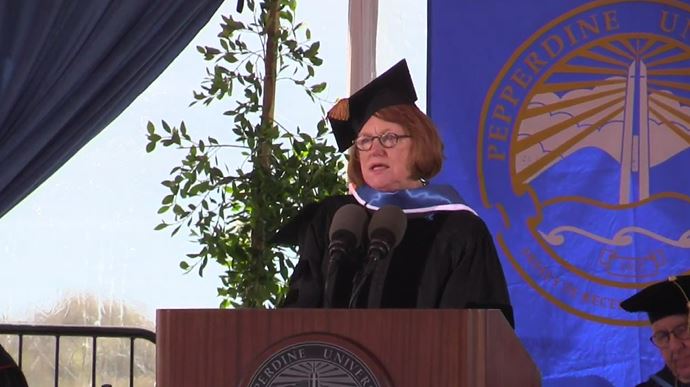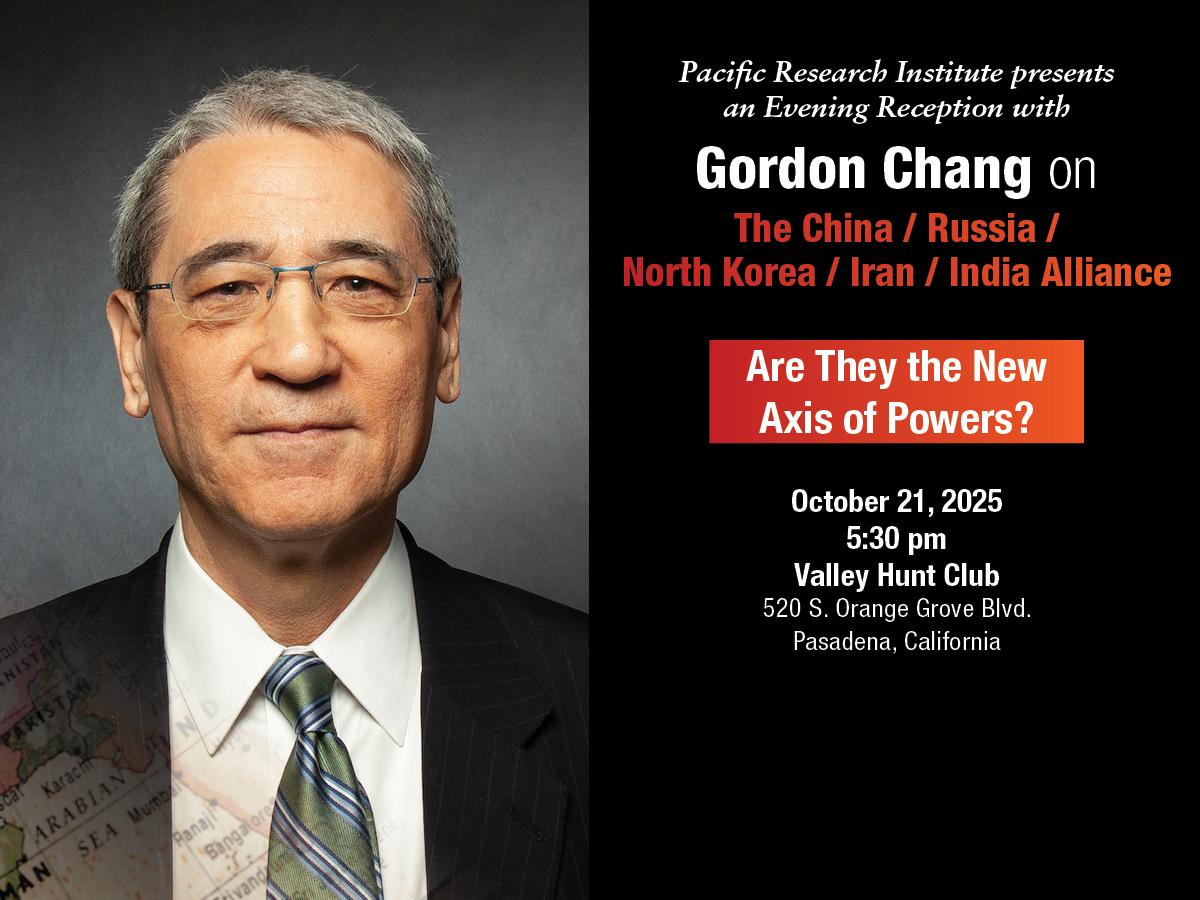Pacific Research Institute President and CEO Sally C. Pipes delivered this year’s commencement address to the graduates of the Pepperdine University School of Public Policy. At the event, she received an honorary doctor of humane letters degree – the university’s highest honor.
The prepared text of Pipes’ remarks are below:
President Benton, Chancellor Adams, Provost Marrs, and especially Dean Peterson thank you for inviting me to be a part of this wonderful event.
And thank you so very much for this honorary Doctor of Humane Letters degree. It is a compliment to all I have learned over the years from mentors like the great Milton Friedman and to all I have tried to teach about enlightened public policy to lawmakers and citizens alike. Again, my deepest thanks.
But let’s turn now to today’s true guests of honor, the Pepperdine School of Public Policy’s Class of 2018: Congratulations! The skills and knowledge you’ve worked to acquire are among the most powerful tools available for bringing practical wisdom to bear on public affairs.
The world needs more high-quality, evidence-based policy research. And we’ll be looking to graduates like you to provide it.
Public policy is a way of translating our shared principles and moral commitments into action. It’s a way to alleviate hardship and correct injustice; for protecting our rights and punishing wrongs; for ensuring that people have access to basic goods like food, shelter, and medical care.
But public policy also has a technical side. Policy must respond to the evidence of its impact. If the facts show that a policy isn’t achieving its objectives — no matter how noble they may be — we must consider a new course.
Consider a few examples from my own area of expertise, health policy. Those on the left and on the right would likely agree that we, as a society, should work to expand access to quality health care. We should make sure that that care improves patient health. And we need to do so in a way that’s financially sustainable.
Expanding access to health care was one of the goals of the Affordable Care Act. The law proposed to do so by, among other things, expanding Medicaid, the health insurance plan for low-income Americans that’s jointly funded by the federal government and the states.
It would seem obvious that enrolling previously uninsured people in Medicaid would improve their health. But in 2013, three years after the passage of Obamacare, a team of public-policy researchers proved that assumption to be deeply misguided.
The researchers looked at data from Oregon. In 2008, the state extended Medicaid coverage to over 6,300 people chosen via lottery.
Researchers were able to compare health outcomes for this randomly selected population with those of a separate group who weren’t made eligible for the program — and thus remained uninsured.
By accident, Oregon had created a randomized, controlled trial — the gold standard of policy analysis.
The researchers found that the newly enrolled Medicaid patients showed “no significant improvements in measured physical health outcomes in the first 2 years,” compared to the control group.
Put another way, people with Medicaid weren’t any healthier than their peers who were uninsured.
The surprises didn’t stop there. A follow-up analysis found that emergency-room use by new Medicaid enrollees increased 40 percent in their first 15 months in the program.
This wasn’t supposed to happen. Authors and supporters of the Affordable Care Act which included expanding Medicaid, argued that the new beneficiaries would stop going to the ER where care is very expensive because they’d have conventional insurance coverage they could use at the doctor’s office.
The facts indicated otherwise.
Medicaid costs a tremendous amount for having so little impact on patients’ health. In 2016, total spending on the program was $565 billion. The federal government’s Medicaid tab is projected to increase 75 percent over the next decade.
That’s . . . a problem.
Perhaps we shouldn’t be surprised by Oregon’s experience with Medicaid expansion. The famous RAND health insurance experiment — a 15-year study that’s considered the largest health policy study in American history — yielded results that line up with the Oregon research.
Between 1971 and 1986, researchers looked at more than 7,700 randomly selected patients. Participants were distributed among five groups. Each received a different form of health coverage. Some got free care. Others enrolled in plans with cost-sharing. One group was covered by a non-profit cooperative.
The results were startling. Those who had free care didn’t experience better outcomes, compared to their peers who had to pay for some of their care.
Patients in this latter group tended to use fewer health services. But this tendency had no significant effect on their health.vi
The RAND experiment and the Oregon Medicaid study undermine a core tenet of the conventional health policy wisdom — that universal, comprehensive coverage is an unalloyed good.
In fact, the kind of coverage we provide matters an awful lot.
Take one of the health reform approaches I’ve long championed — consumer-directed health plans. These high-deductible insurance policies are accompanied by a health savings account, or HSA. Patients can save money in their HSAs tax-free, and then use the proceeds to cover qualified healthcare expenses.
HSAs give patients a financial incentive to spend their healthcare dollars wisely. After all, they control those dollars directly. Whatever they don’t spend, they can keep for the future.
Patients, therefore, have an incentive to shop around for the best value in health care. That could mean, for instance, requesting a low-cost generic drug at the pharmacy instead of a pricier name-brand version.
Providers, meanwhile, have to compete for patients’ business. They can’t just send off an expensive bill to a third-party insurer for reimbursement.
If all those incentives work as the theory would dictate, then overall health spending should decline.
Researchers have put that hypothesis to the test. One paper from 2015 looked at 13 million patients insured by 54 large employers. Businesses that offered consumer-directed plans saw their health spending fall by 5 percent a year over three years, relative to the growth in health costs at firms that did not offer such plans.
Where did the savings come from? Patients moderated their use of outpatient care and pharmaceuticals. Even better, there was no corresponding increase in emergency or inpatient care.
In other words, patients found ways to reduce their medical spending without compromising their health.
Consumer-directed plans won’t solve our nation’s health cost crisis on their own. But the best research shows that they’re an effective way of working toward that universally agreeable health policy goal I mentioned earlier — expanding access to quality health care that improves patient health, and does so affordably.
Health care accounts for one-sixth of our economy. And that share is projected to grow. Finding ways to rein in healthcare spending without sacrificing patient health is one of the defining public-policy challenges of our time. And I hope it’s one that some of you will decide to take on.
But it’s not the only public-policy challenge before us.
How can we ensure that Social Security is around for the next generation? What can we do to make housing more affordable in America’s cities? How can we improve the performance of our nation’s schools?
Regardless of what problem you choose to tackle, I encourage you to challenge the assumptions that underpin the conventional policy wisdom, put evidence at the center of your own policy arguments, and analyze the evidence and arguments of your ideological foes in good faith.
That task won’t be easy. But as the diploma which you are about to receive demonstrates, it is one for which you are most certainly prepared. I wish you all the very best. And thank you for this great honor that you have bestowed upon me.


